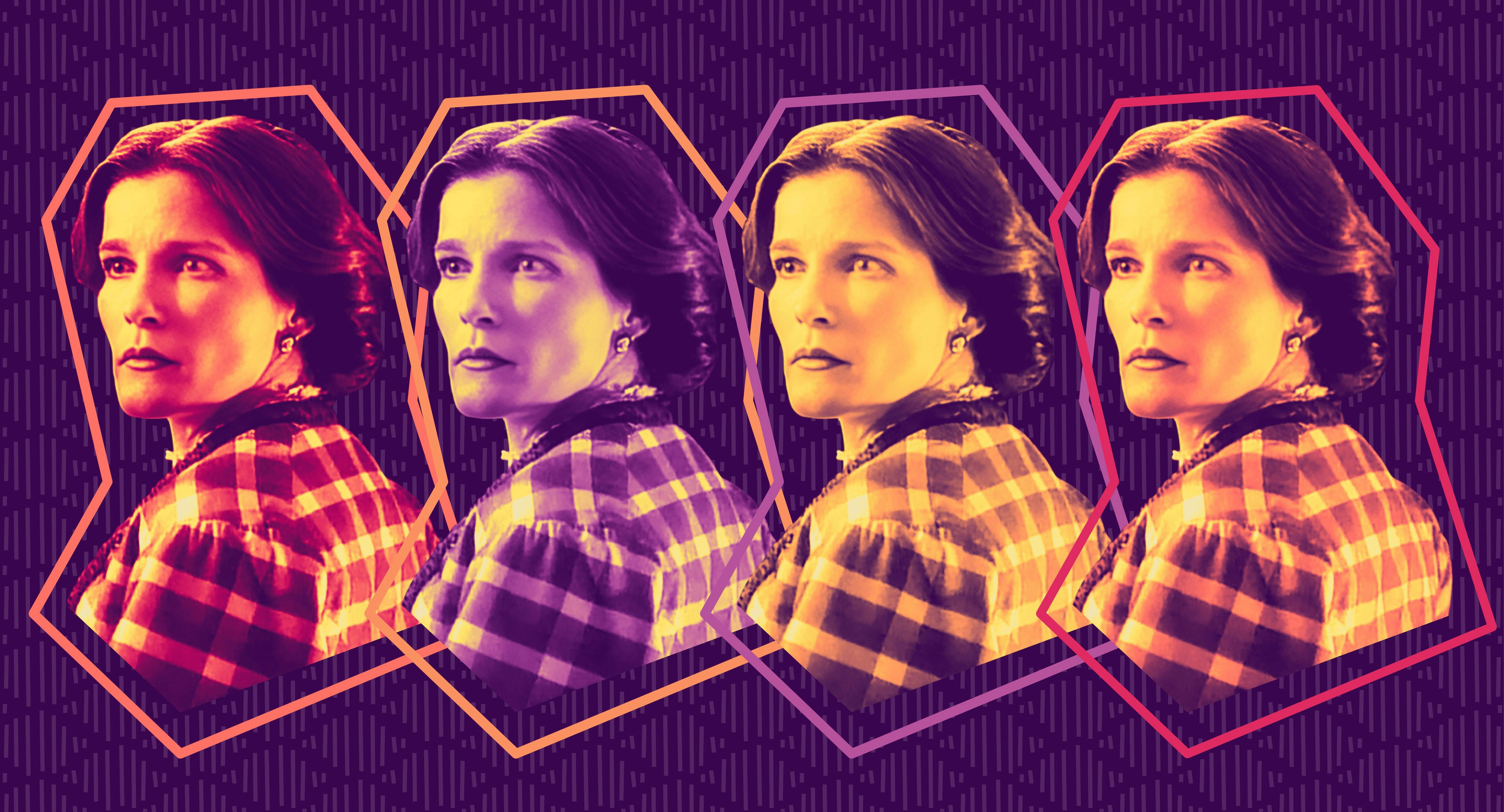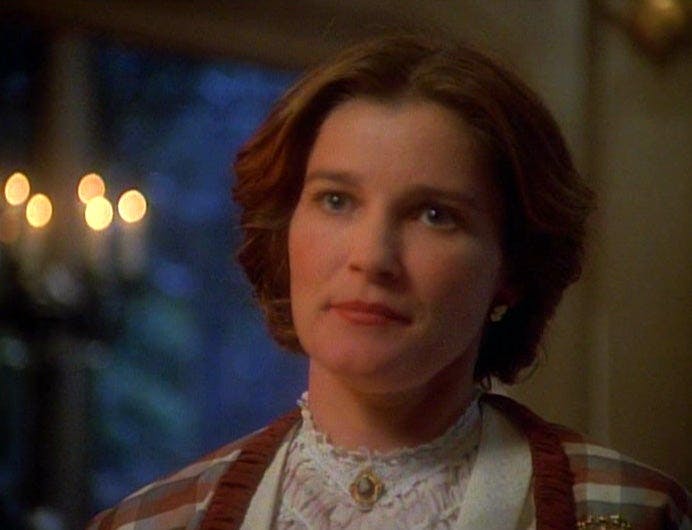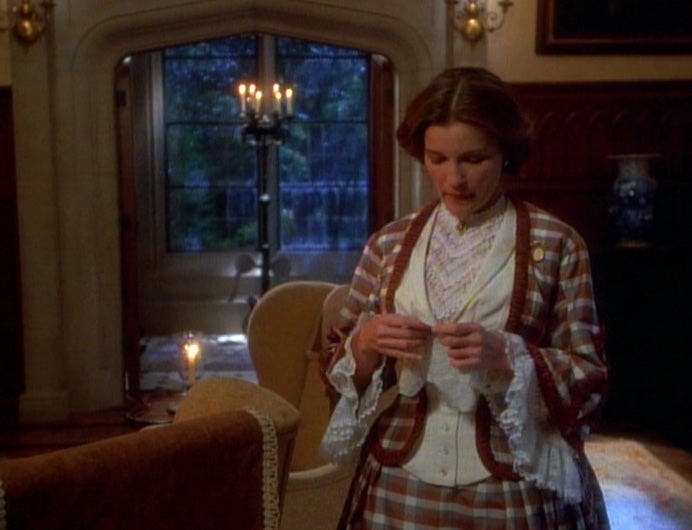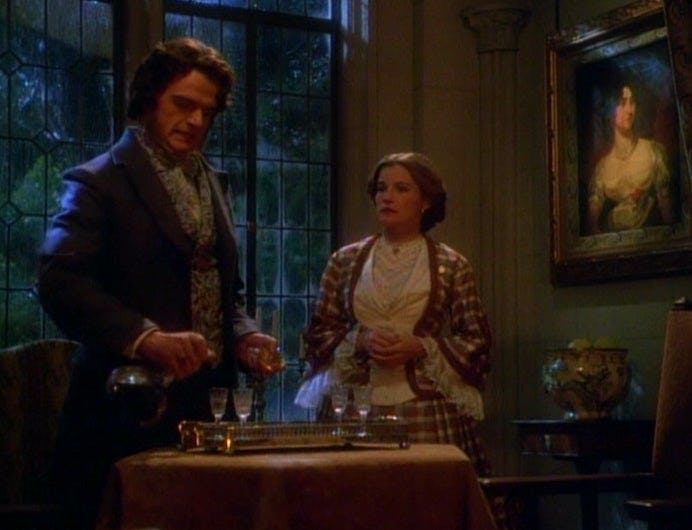Published Dec 12, 2022
The Subtle Feminism of Janeway’s Holo-novel
Janeway’s Ancient England holo-novel has a rich history beyond its brief appearances on the show.

StarTrek.com / Rob DeHart
On the episode “Cathexis,” Captain Kathryn Janeway retreats to the Holodeck for some recreation. Her chosen holo-novel is set in Ancient England and depicts Janeway taking on the role of Ms. Davenport, a governess to the Burleigh family. Within the first few minutes of Janeway inhabiting her character, she’s put in her place by Mrs. Templeton, and later instructed never to go to the fourth floor. In subsequent appearances, her male charge Henry challenges her knowledge of Latin while Beatrice spins a fanciful tale about giving a sampler to her dead mother.
On Star Trek: Voyager, holo-novels can tell you a lot about a person. While the primary purveyor of holo-novels tends to be Tom Paris, there was one holo-novel that had much more significance than initially perceived.
Kate Mulgrew was cast in the role of Captain Janeway at the eleventh hour, and came into a situation where there was no rulebook. Plus, there was some rebuff from fans at the notion of the next Star Trek series being helmed by a woman. Yet, co-executive producers Jeri Taylor, Michael Pillar, and Rick Berman pushed forward with the idea, and Mulgrew was hopeful a female captain would be just what the Star Trek universe needed.

StarTrek.com
”Women have an emotional accessibility that our culture not only accepts but embraces. We have a tactility, a compassion, a maternity — and all these things can be revealed within the character of a very authoritative person,” Mulgrew said in a 1995 interview with Entertainment Weekly. Her read of Captain Janeway from the early days of filming draws a striking similarity to her holo-novel; the scary Victorian horror story falls into the genre of Gothic fiction. Gothic fiction, in turn, has a history of stubborn, trailblazing women who face the odds and win.
The term Gothic originates from the “Goths,” a Germanic tribe believed to be responsible for the fall of the Roman Empire. They left no literature or art of their own, and over the years, the term evolved until the 18th Century when ‘Gothic’ began to become synonymous with barbarism and was used to modify terms such as ignorance and superstition. Gothic fiction quickly established some hallmarks. Stories were typically set in a castle, often featuring tyrants, ancestral curses, hidden passageways, and damsels in distress.

StarTrek.com
While Gothic novels are often thought of as fanciful works of literature derived from fairy tales and medieval romance, they also spawned a heroine unlike any other. In their inception, starting with Horace Walpole’s Castle of Otranto, the genre created three interesting, independent female protagonists that often eclipsed a tyrannical figure and shed preconceived societal expectations.
Janeway’s holo-novel, specifically fits into the realm of the Female Gothic narrative. Janeway embodies the role of a faceless young woman who is about to embark on a series of traumatic events with the help of some terrorizing characters. In The Rise of the Gothic Novel, critic Maggie Kilgour highlights how these narratives are an exposé on domesticity with a helpless female at the mercy of ominous patriarchal authorities. The presence of an external antagonist is typically the main conflict, and the Gothic heroine’s function is to ascertain the secret. Outside of the Holodeck, the story mirrors itself best against the Kazon and Maj Cullah. The patriarchal structure of the Kazon isn’t hospitable to Janeway being in command and she butts heads with them every chance she gets.

StarTrek.com
But the holo-novel acts as more than just a reading of Janeway against the Kazon. The Gothic framework sets the scene for Janeway’s journey as a heroine. Not only is she breaking barriers by being the first female Captain to head a Star Trek series, but her adversaries change.
At first glance, Janeway doesn’t quite fit the mold. A 1977 study in The Pacific Sociological Review attempts to break down the archetypes specific characteristics. They found that a typical Gothic heroine is often under the age of 29, presents as an impoverished gentlewoman, is typically single and attractive, and the crux of her story does not usually revolve around the pursuit of a man. However, Janeway is the driving force of the series. Her ship is the castle, and the mystery she has to unlock is how to get her crew home. You can even see the search for wormholes as looking for secret passages.

StarTrek.com
When the Kazon were finally put to rest at the end of Season 2, Janeway’s adversaries weren’t always so external, and her character began to crossover into the realm of Male Gothic. While The Female Gothic, like Janeway’s holo-novel, tends to see adversaries as external, the Male Gothic projects an internal psychological adversary where the main character comes away recognizing evil as something other than themselves.
As the series progresses, the show takes a few opportunities to lean into Janeway’s mental state a little more and the audience sees her struggling with isolation. This narrative comes to a head in the series finale when Admiral Janeway goes back in time to help her younger self. While the obstacle standing in their path home might be the Borg Queen, seeing Janeway square off against herself is the epitome of internal conflict.

StarTrek.com
Much like how the Federation’s society has evolved and how the series pushed boundaries with casting its first female captain, Gothic fiction has sprouted its own subgenres — Charlotte Brontë’s Jane Eyre is part of the Gothic aftermath, Shirley Jackson’s work belongs to the Southern Gothic canon, and different gothic elements can be spotted in works of several modern authors. In each iteration, the genre changes to reflect current social mores and often relies less on supernatural elements. Janeway is both a daughter and another evolution of this trope. While she may not face some of the same challenges as the heroines of Horace Walpole, of Ann Radcliffe, of Charlotte Brontë, she does fill the same void and proves that just because a medium might be gendered, it doesn’t mean it has to stay that way.
We never get to see how Janeway’s holo-novel would have played out, but given that Janeway is an explorer, I’d like to think that she’d have followed in the steps of the Gothic heroines that came before her.
Into the #Starchive with Captain Janeway's OG Uniform
This article was originally published on April 27, 2020.
Lauren Busser is a writer of fiction and non-fiction and currently an associate editor at Tell-Tale TV. She has a B.A. from Sarah Lawrence College where she wrote her senior thesis on female friendship in the Gothic novel. You can find her on Twitter @LaurenBusser.
Stay tuned to StarTrek.com for more details! And be sure to follow @StarTrek on Facebook, Twitter, and Instagram.

